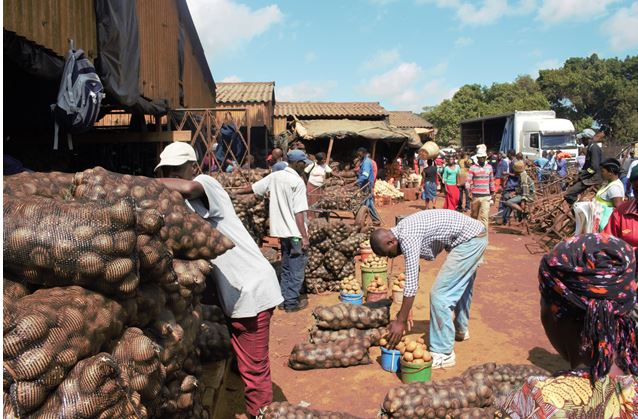By Charles Dhewa
During times of socio-economic stability, farmers and entrepreneurs can afford to rely on one commodity or value chain. Not when climate change is announcing itself in unpredictable ways. That is why experimentation is no longer a preserve for schools and universities. Farming areas and markets are becoming laboratories for intelligent experimentation among farmers, consumers, traders, artisans and ordinary people in developing countries. These actors have realised that prescriptions from private seed companies and livestock enterprises are inadequate in coping with climate-induced challenges.
Informed use of available resources
Food producers are witnessing how high yielding crop varieties and livestock breeds are being rendered useless in a rapidly changing climate. Instead of knowing a lot about one commodity, farmers are being forced to experiment with a wide range of commodities ranging from crops to fruits, herbs and different classes of livestock. With rainfall patterns becoming sporadic and the cost of inputs increasing, food producers are being compelled to examine and learn from how different crops use nutrients. Such knowledge can no longer be left to extension officers or companies selling inputs like fertilizer whose main motivation is making a profit at the expense of uninformed farmers.
Water extraction tendencies
Some of the recurring questions from farmers relate to the extent to which different commodities use water. Those conducting their own experiments are noticing that commodities like cabbage are watery and can extracts a lot of moisture to a point of drying the soil while looking for water. Also in this category are high value crops like broccoli and cauliflower. From the experimentation lessons, smallholder farmers would rather do leafy vegetables than cabbage. If cabbage does not get enough water, the head becomes small and therefore unprofitable on the market. High quality and a big head size come from nutrients plus a lot of water. On the contrary, farmers are learning that tomatoes do not consume a lot of water. A farmer can irrigate in 10-14 day cycle depending on time of the season, which cannot be done with brassicas like cabbage. Like tomato, peppers also do not consume a lot of water.
Another high water consumer is potato according to experiments from smallholder farmers in east and southern Africa. Without abundant water you cannot produce potatoes. The level of irrigation and amount of water required by potatoes is too high for most farmers. That is why the majority of smallholder farmers in communal areas cannot produce potatoes. Most farmers end up seeking refuge in in tomatoes which you can simply irrigate with a can. The quality and shelf life of potatoes is determined by soil type, texture and weather. In Zimbabwe, the eastern highlands have the best weather for potatoes, especially Nyanga which is not too hot and so the soils are not too hot either. Heat within the soil tends to affect potato shelf life on the market. A majority of consistent producers now know that commodities that need a lot of water have high water extraction capacity from the ground, high soil nutrients depletion and a heavy irrigation budget.
Nutrient uptake by different crops
Seed acquisition decisions by many farmers in developing countries are no longer just influenced by the price of input but other critical considerations that speak to a changing climate. Different classes of farmers are now paying attention to differences in nutrient uptake by diverse crops. They have become aware that some crops are heavy feeders while others are light feeders. Heavy feeders include potatoes, cabbages and, to some extent, tomatoes depending on varieties. Light feeders include lettuce, onion, garlic, leafy vegetables, carrots, peas and fine beans.
Heavy feeders take a lot of nutrients from the soil the whole journey from planting to maturity compared to light feeders. This means farmers have to apply more into the soil for heavy feeders to grow better. Heavy feeders consume what is in the soil and what farmers apply and when not fed adequately, they draw more nutrients from the soil and leave the soil without nutrients. Due to quality issues, some heavy feeders like potatoes and cabbages require additional special nutrients in the form of trace elements which light feeders can do without. This means heavy feeders need more inputs, in the range of $8 – $10 000/ha compared to light feeders whose cost of inputs may be half that amount. Among field crops, heavy feeders include cotton whose deep roots can stretch wider and deeper in search of nutrients and water.
Labor-intensiveness, easy of harvesting and other trends
Farmers are also discovering that while fine beans and peas are more labor-intensive during harvesting because they need meticulous handling to avoid bruising, harvesting cabbage is merely cutting the stem and loading is more like throwing. Potatoes are also easy to harvest but very labor-intensive. You need a lot of manpower, first to arrange potatoes in small heaps, somebody to pack into bags, transporting to the main heap from where grading by size begins as well as identification of rejects. Then somebody pockets them manually, followed by someone scaling them into 15kg pockets, then someone comes to seal the pockets. To avoid potatoes suffering some bruises, they have to harden and mature in the field.
Some of the emerging trends
Economic hardships in several developing countries have triggered urban farming and the proliferation of technologies like water pumps, solar pumps and diesel/petrol-powered engines. Many urban dwellers are now producing high value crops like spinach, lettuce, broccoli and leafy vegetables like covo, rape and others that are delivered to supermarkets daily. This has disrupted the wholesaling model, with farmers in distant areas being muscled from the market. However, rural farmers still have advantages in producing vegetables with a superior taste, free from impurities associated with contaminated urban soils and water.






